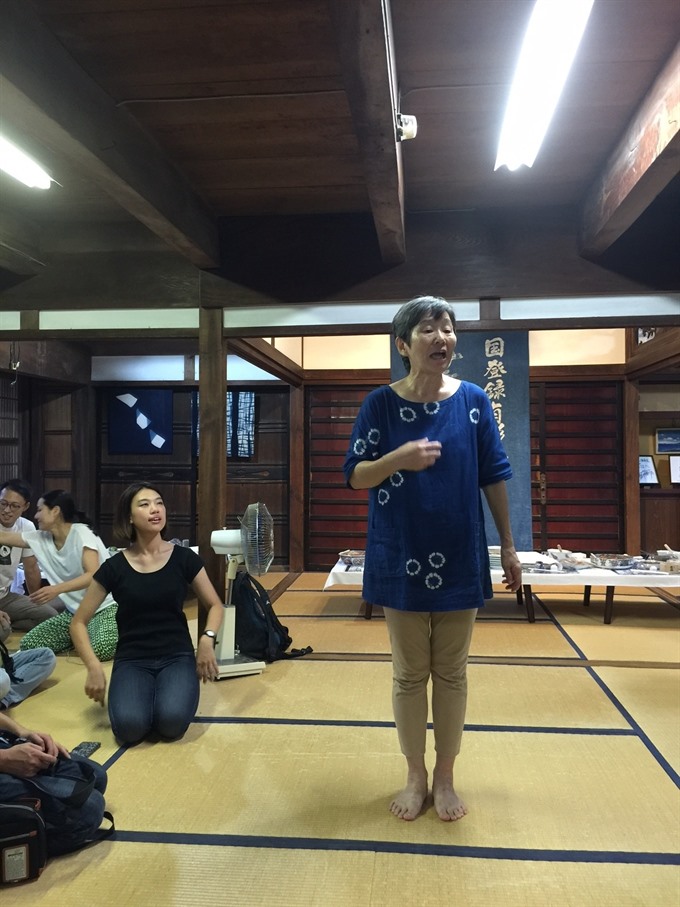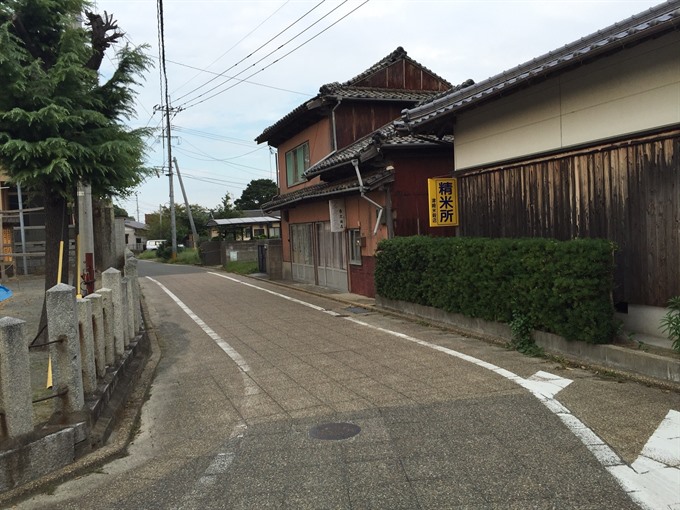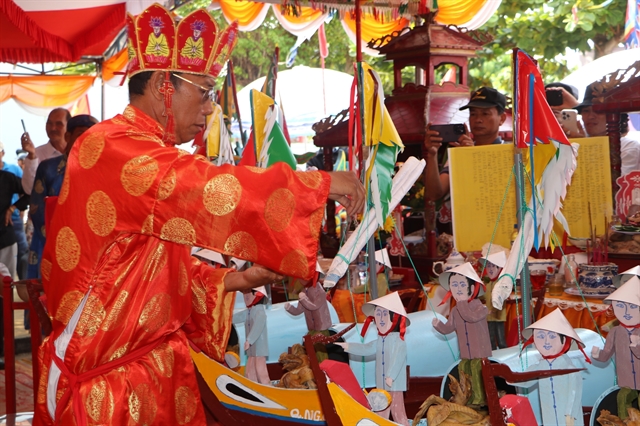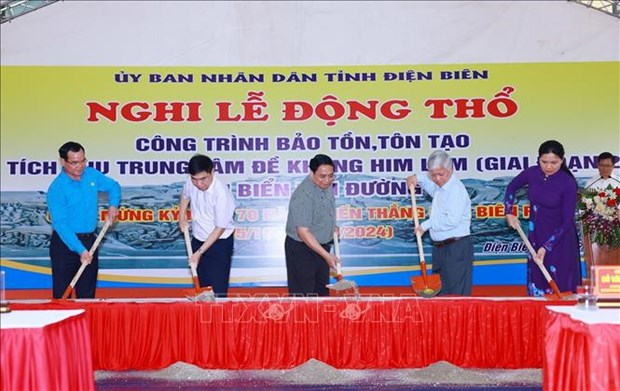 Features
Features

Tsuyazaki Village in Japan is fighting a demographic force by welcoming new settlers and evoking a sense of community, reports Hoang Anh
 |
| An obasan gives visitors a tour of the village’s hundred-year-old Indigo House. |
Tsuyazaki Village in Japan is fighting a demographic force by welcoming new settlers and evoking a sense of community, reports Hoang Anh
KYUSHU — It was around noon as we walked down the streets of Tsuyazaki Village.
Large Japanese traditional houses stood behind wooden fences along the streets; many of them looked rundown. Some appeared to be in a state of ruin.
“Those houses are extremely expensive to build. I don’t think I can ever save up enough money to build one in this lifetime,” said our Japanese guide, “It’s such a shame they are all falling apart.”
“They are just gone,” she said, shrugging, when asked where the house owners were.
“It’s the same thing that happened to the whole town. People just left or died off naturally,” she said.
Once a thriving fishing village in the northern Kyushu Island of Japan and home to the largest sake maker in the whole prefecture – the Toyomura Brewery – Tsuyazaki has clearly known better days.
While villagers are keeping the streets clean and tending their gardens with care, it is also obvious that they are facing an uphill battle. Slowly but surely more parts of the village are crumbling; more houses are abandoned with nobody left to live in them.
Japan is well-known for its aging and declining population. Fukuoka – Kyushu’s largest city, about an hour drive from the village – is an exception to the rule as the city’s population is not only growing, but also getting younger. This is happening at the expense of small villages and communities, including Tsuyazaki, as young people are often moving to big cities en masse.
In the former bustling fishing village, old houses have old people living in them. Businesses have closed and a large part of villagers’ income now comes from the pension fund. Even the sake brewery – their prized jewel – had to stop production.
Fighting back
It’s uncharacteristic of the Japanese, however, to take things lying down.
The village’s band of brothers, sisters and obasan (middle-aged women in Japanese), who are engaged in this battle against the demographic shift that has affected the whole nation, has some unusual and surprising characters.
Meet Satoru Yamaguchi, a former architect who used to work for a large construction corporation, who decided not only to abandon his job and his city life but also to move his entire family to settle down in Tsuyazaki.
“I was a town-destroyer,” he joked. “My job was to go to small towns like Tsuyazaki and build projects on top of them. But this is my home now.
“You know what nani mo nai means in Japanese? It means ‘there is nothing’. That’s what people say about small towns like Tsuyazaki,” Yamaguchi said.
“I used to believe that myself. But this town changed me. It has given me so much.”
 |
| Quiet and empty streets of Tsuyazaki Village. VNS Photos Hoàng Anh |
Yamaguchi and his wife Mika got married at Tsuyazaki. He said it was the first wedding that the villagers had seen in years. Naturally, there were a lot of people coming over to congratulate the couple, but he was deeply moved when they all told him how happy they were to see a wedding in town.
The rare wedding, a common occurrence otherwise, was a sign that life was returning to the village.
Mamoru Hosoi and his family came to Tsuyazaki a few years back. Hosoi runs an art workshop which he restored from an old abandoned building in town. He teaches kids and adults how to create works of art or make daily-use things like tables, chairs and spoons.
“Of course, one can go to the store and buy their furniture. That’s the quick and easy way. But there is certain value in creating them slowly with your hands,” Hosoi said.
This was the idea behind the family’s decision to move away from big cities. They want their boy to grow up here in a small town, closer to nature, and more importantly, closer to other people.
We were invited to visit the Indigo House – a dye merchant house renovated to the equivalent of Viet Nam’s communal house, a place for the villagers to gather.
There must have been at least ten obasan who were busy cooking and setting the table as one gave us a tour of the house.
I could not understand the obasan’s memorised speech entirely, because of her heavy accent and broken English, but her enthusiasm and sincerity was moving, and motivated me to listen hard.
Second wind
An obasan, Tsubasa-san (san is a Japanese honorific used to show respect) told us that the idea of accepting strangers to settle down in the village was not easy to accept. But they have learned over the years that making an effort to get to know each other helps.
“I’ve lived a long life. In the end, we are all people and we are very much alike,” she said, “When I followed my husband here fifty years ago, people of the village were very helpful and welcoming. I’d like to do the same to those youngsters who want to make it their home.”
It is difficult to reverse the tide, but their efforts were starting to produce results. Tsubasa-san told us more and more young people were coming to the village of late.
As we walked down small alleys to get to a nearby beach and view the sunset, Yamaguchi showed us a house that he, with the help of the villagers, had restored, turning it into a guest house.
“We went through a lot of trouble to contact the owner’s next-of-kin. Even after getting their permission it was costly to revive an abandoned old house. But everyone chipped in one way or other,” he said.
Yamaguchi said he hoped the village would attract more tourists and visitors from nearby Fukuoka, who may be looking for an escape from the busy city life.
On the way back to the Indigo House for dinner, we found a sumo ring – for traditional Japanese wrestling – under construction in the village’s temple courtyard.
“It’s for the upcoming autumn festival. The entire village is looking forward to it,” said Yamaguchi.
This is the temple where Yamaguchi and his wife Mika got married with the entire village as witness. Just across the street is the village’s kindergarten, where his four-year-old daughter is going to.
“I want my daughter to grow up here. This is our home.” — VNS









